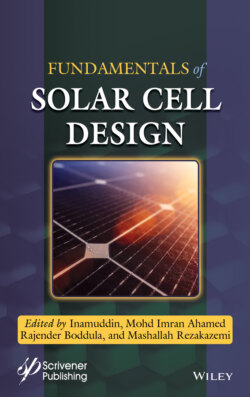Читать книгу Fundamentals of Solar Cell Design - Rajender Boddula - Страница 13
1.1 Introduction
ОглавлениеWind energy is renewable, land around turbine may be used for agriculture, and, further, newer technologies may provide better ways of converting wind energy. There are certain limitations in the wind energy conversion like: unreliable wind source, low production of electricity, higher capital cost, environmental damages, and higher level of noise production. Coal energy is also in practice in some countries and they may be continued, but there are disadvantages like carbon-dioxide production, environmental pollution due to coal burn waste accumulation, and problems associated with coal mining. Fossil fuels are also in practice for generating electricity in some countries, because they are inexpensive, portable, and easily burnt. Limitations to fossil fuels are nonrenewable source, emissions due to burning, and global warming. Geothermal energy is a base load energy source, safer than fossil fuels, and globally sustainable. Disadvantages of this geothermal energy are contamination of unwanted trace elements, localized depletion of energy, and energy imbalance leading to geological instability. Hydrothermal energy for the production of electricity is also in practice in some countries, which has advantages like controlled way of electricity production, ease of water pooling in dams, and utilization of water released after electricity production for irrigation/agriculture. Other disadvantages are higher capital costs, ecological and environmental disturbance, possible wreckage of dams leading to flooding, and hostilities arising due to improper sharing of water. Nuclear energy is another form of energy that can be utilized for generating electricity and is practiced in some countries. It is relatively a clean energy, most concentrated energy and does not require big places/areas. The disadvantage is potential accidental hazards due to control deficiencies, management failures, and possible leaks (nuclear fission process).
Energy from SUN is the most abundant form of renewable energy reaching the earth and is known as Solar Energy. Radiant light and heat emanating from SUN and reaching the earth can be utilized for various purposes. Solar energy is renewable, clean, and green and is a secured type of energy reaching earth 200,000 times more than the electrical energy generated in a day on the earth. Earth receives 174 peta Watts of sun radiation, in the form of 8% UV radiation, 46% visible light, and 46% infrared radiations, and is absorbed by earth atmosphere, oceans, and land mass. Because of the clean, green, and abundant renewable energy coming from sun is found to be more attractive for the researchers to work on the conversion of light energy in to electricity; presently, this has become a globally attractive and potential research domain to devise solar energy trapping units in to usable form of electricity, which can serve global energy requirements. Solar cell or photovoltaic (PV) cell is a device or unit which converts light in to electricity and globally research scientists are making all out efforts to prepare an efficient solar cell with an excellent photo-conversion efficiency, such that it can be developed as viable technology for society. Silicon solar cells are already in the hands of citizens/public having ~26% efficiency with some limitations, and this situation placed research on organic solar cells the most demanding and desirable field.
